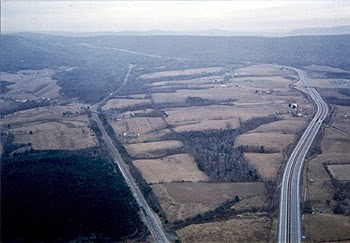 |
| There is a 13-mile stretch of the Turnpike, with three tunnels and a travel plaza, east of the Breezewood area, that was bypassed in 1968 and dubbed "The Abandoned Pennsylvania Turnpike." |
 |
| PA Turnpike: the Highway of Tunnels |
Divided Highways, Parkways, and Expressways
One such
innovator was Englishman Hilare Belloc, who in 1924 wrote a book entitled The
Road. Belloc proposed great arterial roads joining main population centers
that were to be wide, as straight as possible, with no intersections at grade,
and finally having limited access. In a chapter entitled “The Future” Belloc
stated that
A very few great arterial roads joining
the main centers of population would have far more effect upon our present
difficulties than their mere mileage would seem to warrant. There could be no
question of stopping the new form of traffic upon ordinary roads remaining,
which might be twenty or fifty times those of the new roads. But it would be of
such advantage for long-distance travel to use the great arteries that at the
expenditure of greater mileage you would find the new traffic seeking them at
the nearest point upon one side and clinging to them for as long as possible.35
Essentially,
Belloc was envisioning the modern expressway, as were a few of his
contemporaries such as Arthur Hale, who patented the cloverleaf in 1916.
These kind
of roads were built in Mussolini’s Italy during the 1920s (the autostrade)
and in Hitler’s Germany of the 1930s (the autobahnen).36
Adolf Hitler’s highways were dramatically innovative roads that were perhaps
the most publicized and visible products of the new regime. They have also
proved to be the most enduring of the Third Reich’s material legacies, still
carrying traffic, and thus promising to fulfill Hitler’s boast that “the
construction of these roads will give the German people traffic routes for the
most distant future.” The autobahnen
were critical to Hitler’s plan for the mass motorization of Germany, first
announced at the Berlin auto show of 1933. Between 1933 and 1936 auto
production increased five times. These roads were also important aspects of
Hitler’s plan eliminate unemployment; by 1936 some 130,000 men were employed
directly and 270,000 indirectly in industries like cement mixing and stone
masonry. Construction workers, living under a military-like regimen, were
housed in isolated camps near the work sites.
The
autobahns of the 1930s amounted to beautiful works of civil engineering. They
blended organically into the landscape; it was said that those who constructed
them had a real concern for the environment. Autobahns were built not to
disturb scenery and landscape unnecessarily, and they were designed to
contribute to the driver’s appreciation of the natural surroundings.
Even though
most work went into conventional road building during the Depression years, the
seed of the expressway system was sown at that time. Although federal funds
went into 2-lane projects, ironically perhaps, local funds were for the most
part used to design high-speed motor traffic highways. This was especially true
in Connecticut, with the opening of the Merritt and Wilbur Cross Parkways. In
Pennsylvania, where in 1937 a Turnpike Commission was created to build a toll
road using an old railroad right of way, a mix of federal and state funds were
allocated.
Some
federal funds came from the Public Works Administration (PWA), and surveys had
actually begun in 1936. Features of the new road included four 12-foot wide
lanes, a 10-foot wide median strip and 10‑foot side berms, and a limited access
with 1,200 foot entrance and exit lanes. On October 13, 1940, 160 miles of
turnpike between Carlisle (West of Harrisburg) and Irwin (east of Pittsburgh)
was opened. It soon became the preferred way of truck traffic, since 7 tunnels
were used, the grade on the Pennsylvania turnpike had been restricted to 3 percent
and thus fuel consumption was decreased considerably. Finally, the driving time
between Harrisburg and Pittsburgh was cut from five and one-half hours to two
and one-half. Initially, the Pennsylvania turnpike had no speed limits, but in
April 1941 a 70 mph limit was set, although in tunnels one had to maintain a
speed of 35 mph.
As
successful as the Pennsylvania Turnpike became, across the country in Los
Angeles similar developments were taking place that proved to be equally as
successful. Lloyd Aldrich, who became Los Angeles city engineer in 1933, became
a principal champion of the freeway, and he was one of the first to perceive an
essential element for a modern metropolis; namely, that the time required to
complete the journey was far more important than the distance covered. In 1940
under Aldrich’s direction the Pasadena freeway was completed, the first link in
a proposed 300 mile web of urban freeway.
The first
of the LA freeways was named the Arroyo Seco Parkway. This road had no number
designation, and originally the speed limit was 45 miles per hour. With two
lanes of traffic in each direction and a broad shoulder for emergencies, the
route ran from downtown Los Angeles to Pasadena. At the time, it was considered
an engineering marvel, although it is obsolete by today’s standards. Indeed,
most current-day drivers would consider the road dangerous; merging is almost
immediate and right shoulders are narrow. Despite the fact that one must often
stop before gaining access, it is a heavily-used thoroughfare, with 3 three
lanes in each direction.
Thus, on
the eve of World War II, America had taken critical steps in highway
construction that would be instrumental to the explosion of interstate highways
beginning in the 1950s. Regions were
now linked together, tourism was now a part of middle-class life, and trucks
were moving an increasing percentage of manufactured goods and agricultural
produce.





No comments:
Post a Comment